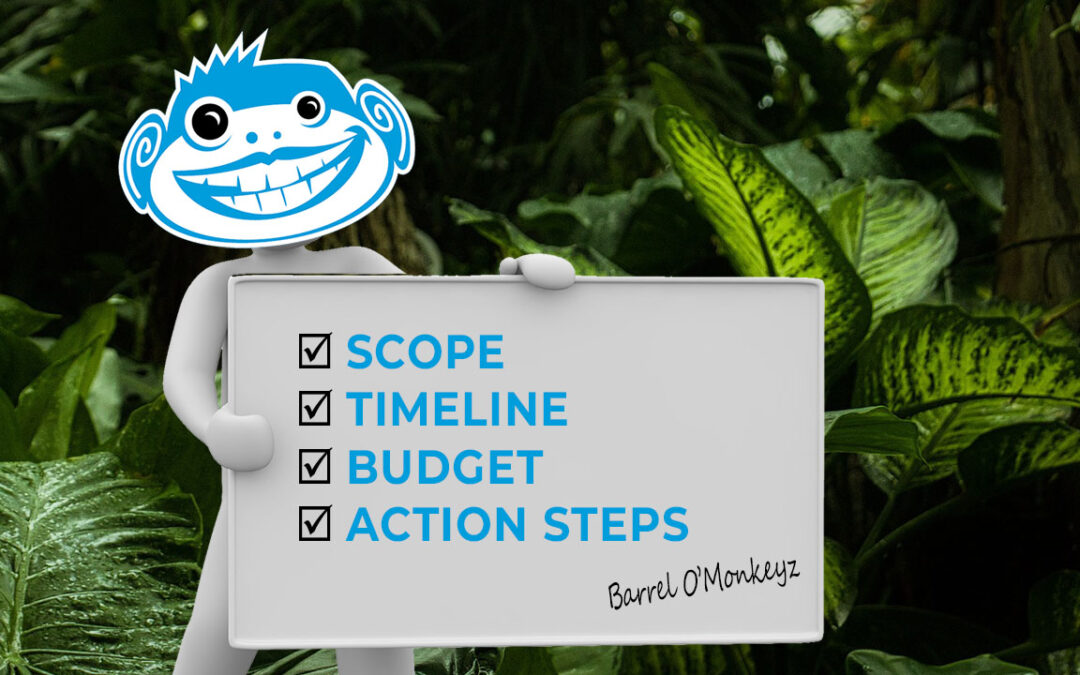When Barrel O’Monkeyz is working on a project, we don’t like surprises, nor do our clients, so we “get it in writing.” That way, we can all be on the same page about what the work will entail, how long it will take, who’s doing what, how much will it cost, and more. I invite you to read my blog on this topic from a few years ago. Enjoy!
Set Expectations Now to Eliminate Misunderstandings Down the Road
In all relationships, there are three truths: my truth (the truth as I see it); your truth (the truth from your perspective); and the “real truth” (something in-between your perspective and mine, which is probably much closer to reality).
In personal relationships, the hope is that the gap between one person’s truth and the other’s is so narrow that it becomes negligible and life and the relationship can continue merrily along day-to-day, week-to-week, and so on. No harm, no foul.
In business, however, the gaps between both parties’ versions of the truth can be quite broad at times—and that’s when trouble can start to brew.
IT’S ALL GOOD—TO A POINT
In my opinion, for the most part, people are inherently good. It’s rare for anyone to enter a relationship with truly bad intentions. However, I think it’s also quite common for parties to enter a relationship with expectations that don’t necessarily align. In other words, their respective perceptions of what’s true are not in sync. That’s when things can go awry.
To say that another person’s truth doesn’t match my version of the truth does not make that other person (or me) a liar. It simply means our perspectives on a topic, issue, or matter differ—that his or her expectations around a situation are different from mine . . . and nothing sours a relationship quicker than unmet expectations.
GET IT IN WRITING
In a personal relationship, it’s probably not realistic or recommended to outline your expectations and the expectations of your friend, partner, or spouse in writing to ensure you’re both on the same page. That just slows things down and throws up unnecessary red flags that complicate things (believe me, try it and see what happens!). In business, however, getting things in writing is not only realistic—it just makes good sense.

Clients and service providers come in all shapes, sizes, and attitudes around ways of working.
- There are those clients who perpetually “want it yesterday,” while there are some service providers who always seem to be a day or so behind in delivering the goods. What might seem like a reasonable timeframe to one person, might seem like a rush job to another.
- Then there are those clients who seem to “check out” for long stretches at a time. They get fired up, rolls up their sleeves . . . and then simply go quite for weeks on end. Similarly, some service providers seem to work hard to get your business, then disappear from the scene once the work commences.
These kinds of disconnects—or the potential for them—are why any good business relationship should start off with a written agreement. While you probably don’t need a 40-page contract that could stand up to the scrutiny of the SCOTUS, both parties to any such agreement should want it to include terms around:
- Specific descriptions of the work to be performed or the product(s) to be delivered, often called the “scope of work.”
- Timelines and timeframes around deliverables and the service provider’s responsiveness, as well as around client responsibilities to deliver necessary information, review materials, and provide approvals.
- A clear action plan that spells out project initiation, ideation, approval processes, implementation, measurements of success, and refinement as might be needed.
- Budget guidelines about what the product or service will cost, and any contingencies.
- A clear outline of what happens should the scope of work change during the course of the project, including impact on timelines and budget, as well as what conditions or events might constitute a change in scope.
- An understanding of what happens at the end of the project, whether the project reaches its logical conclusion or is cancelled early. In other words, what obligations remain for payment, deliverables, etc., when the work is completed?
For some laughs, check out this “Field Guide to the Wonderful World of Clients” on Pinterest. 15 Types of Challenging Clients.
DON’T BE SHY
Sometimes people feel awkward starting off a new business relationship by asking the other party to commit to something in writing. Much like asking for a pre-nuptial agreement with your intended spouse, perhaps they feel it shows a lack of trust in the other entity, which they feel is never a good way to kick things off.

At Barrel O’Monkeyz, we feel entering into these kinds of agreements from day one helps get everyone’s expectations onto the same page. That way, when a client asks us to change the color of “X” and the layout of “Y” for the tenth time, they’re not shocked when we remind them that we originally agreed to only 1 or 2 rounds of creative and that such requests represent a change in the scope of work, thus impacting budget and timeline. Similarly, when we’ve agreed to deliver Project “A” within timeframe “B,” we know the client has every reasonable expectation to believe that will happen, barring an act of God.
Setting expectations now helps eliminate misunderstandings down the road, which is not only good business sense . . . it’s the truth.
ABOUT US
Barrel O’Monkeyz is a San Diego-based strategic marketing agency. We serve as a seasoned, outsourced marketing team for companies looking to ramp up sales and launch new products. Our barrel is full of talent and creative minds ready to prove we don’t just monkey around! Contact Barrel O’Monkeyz Today!

